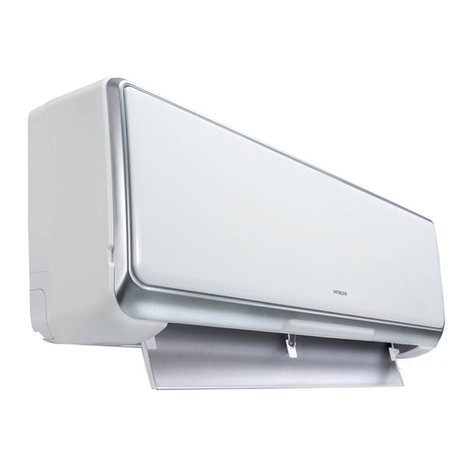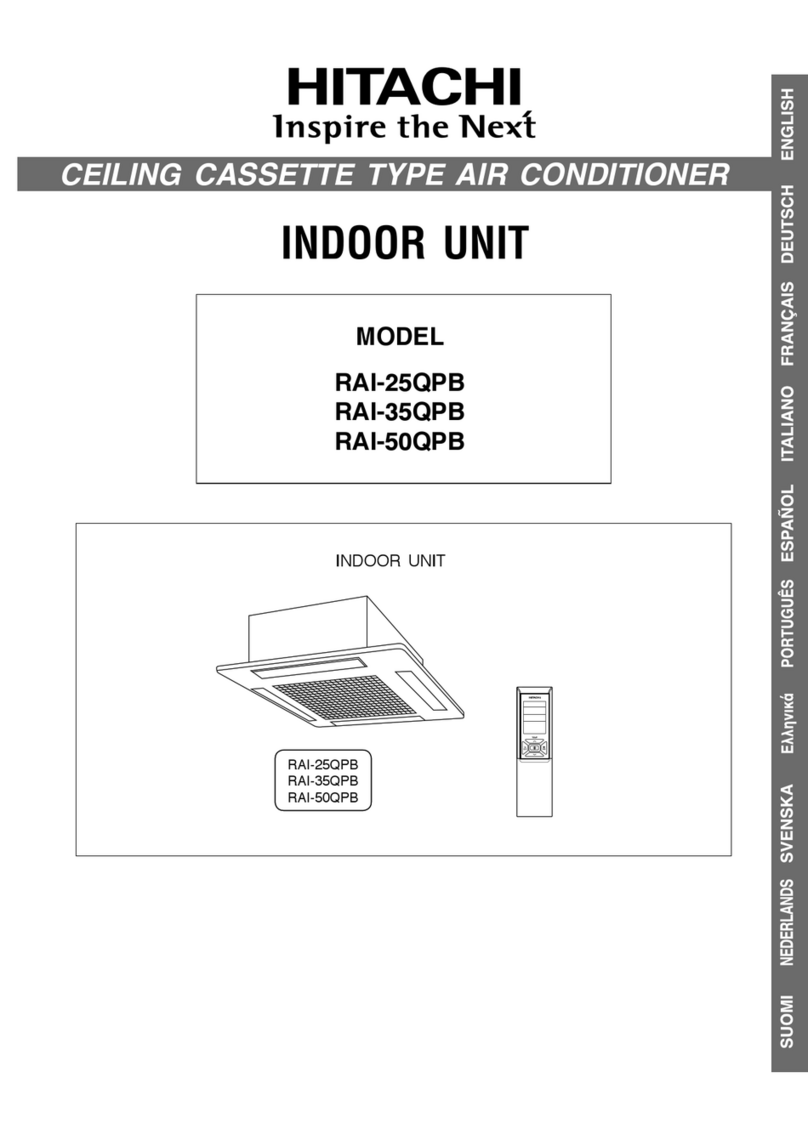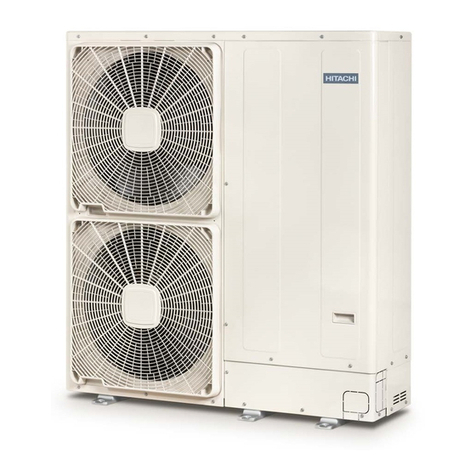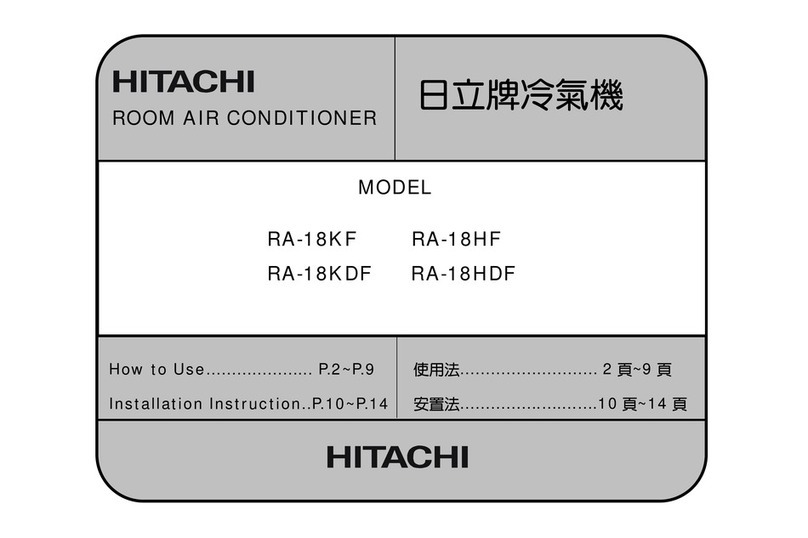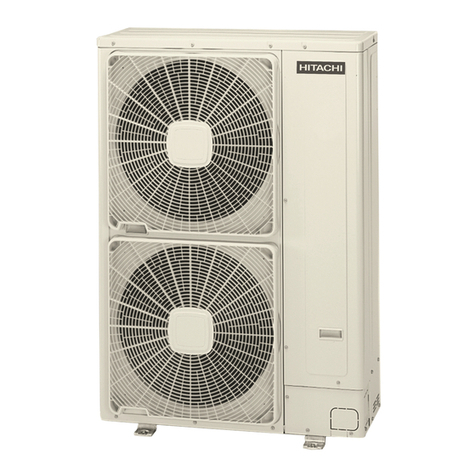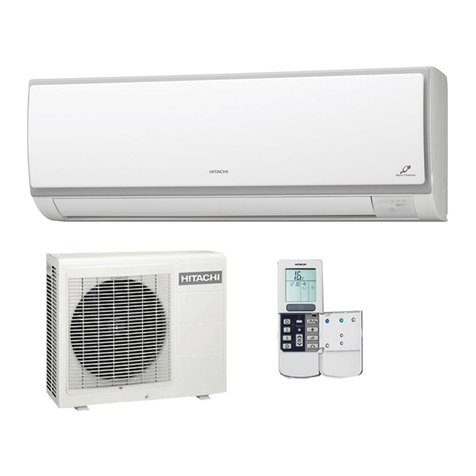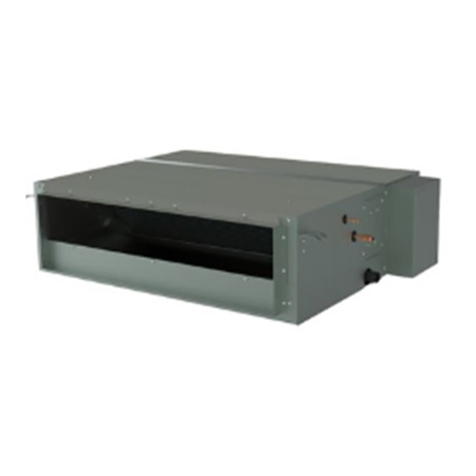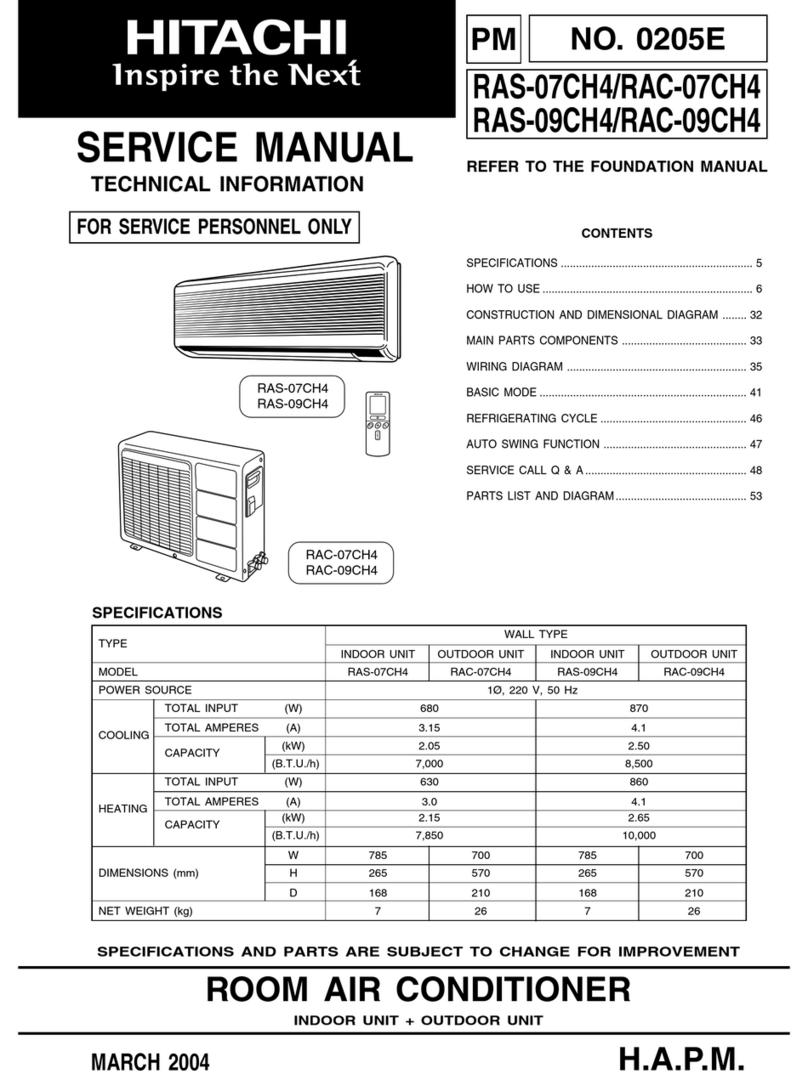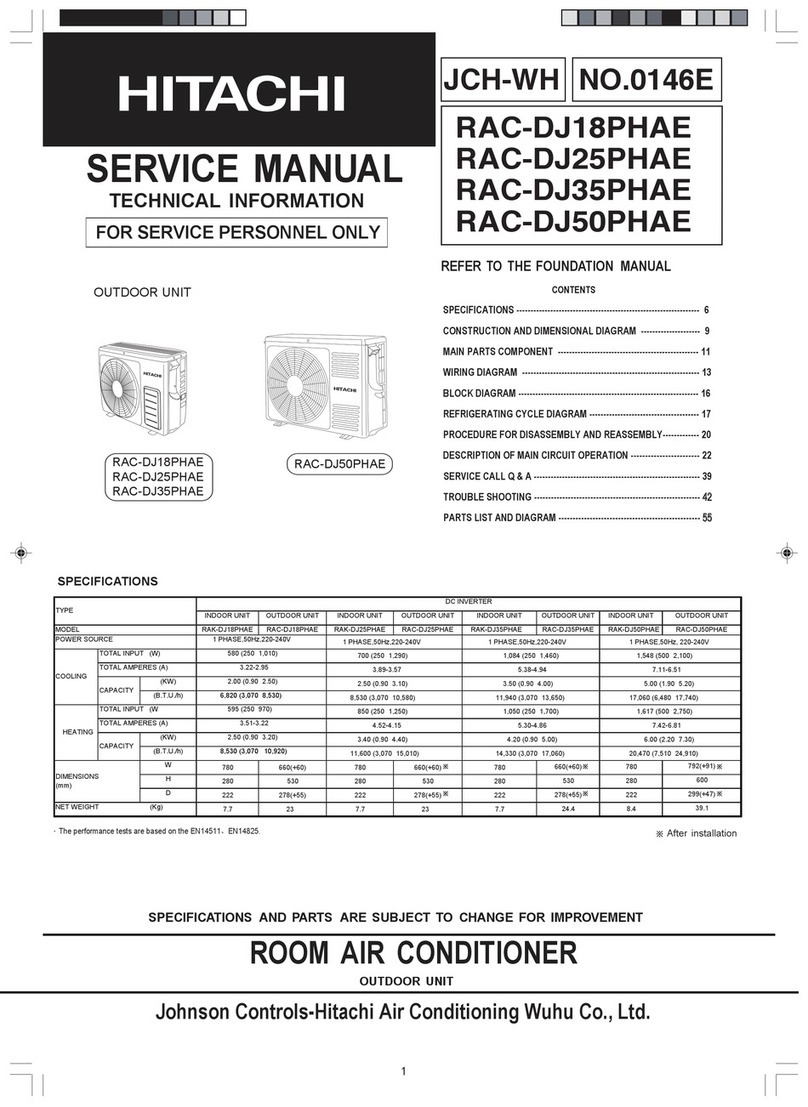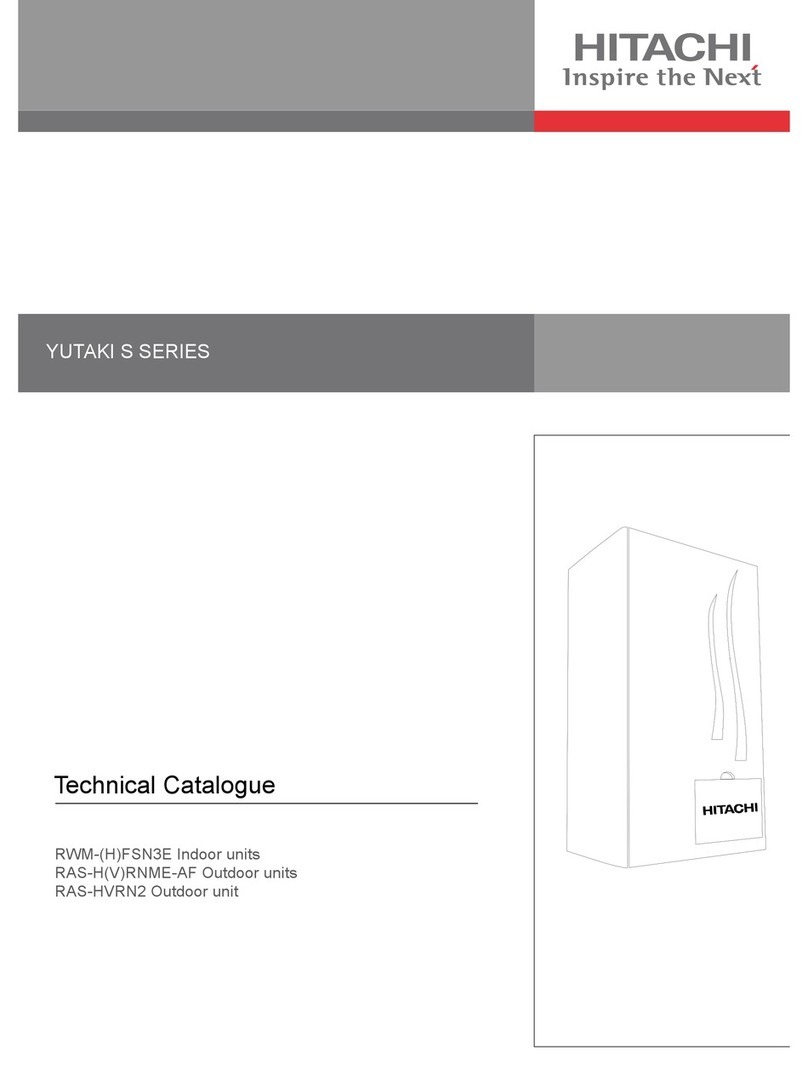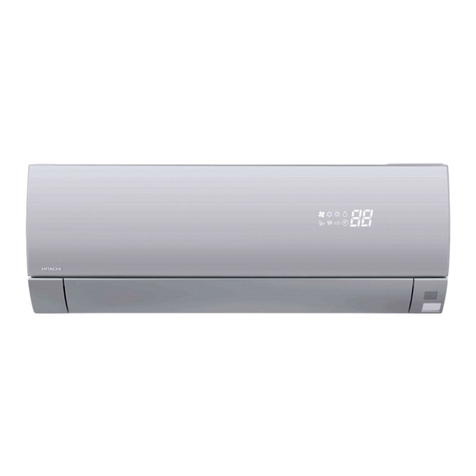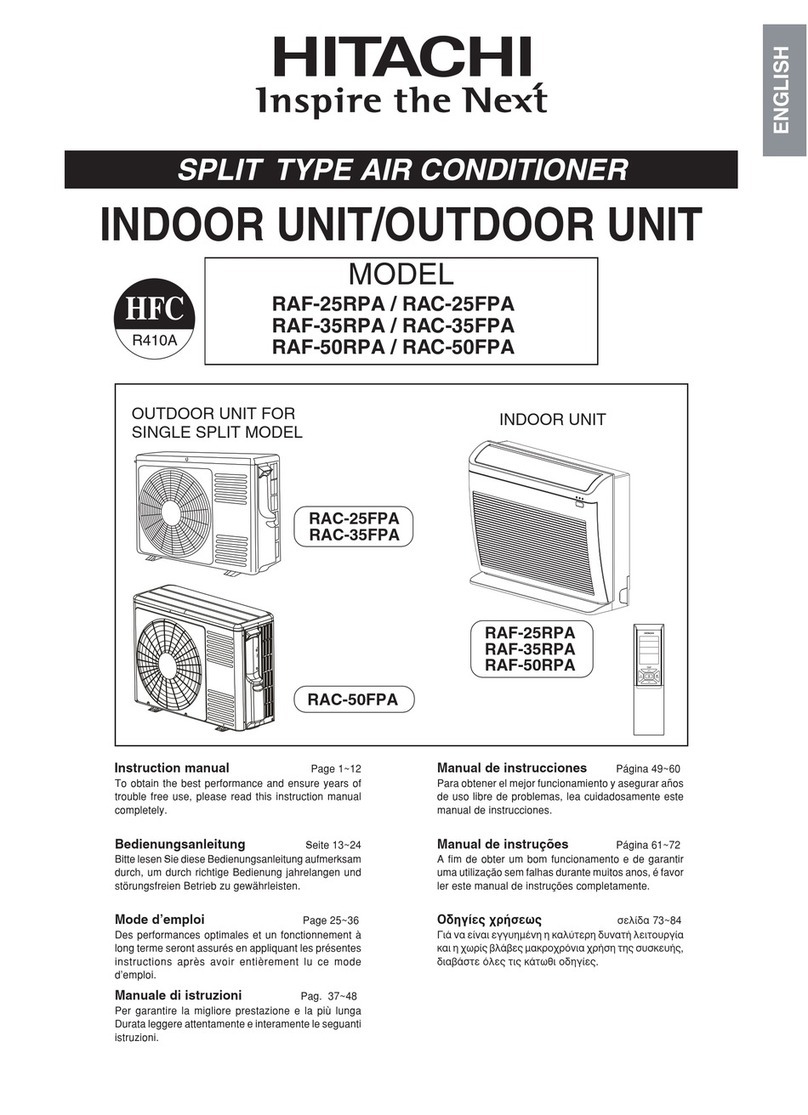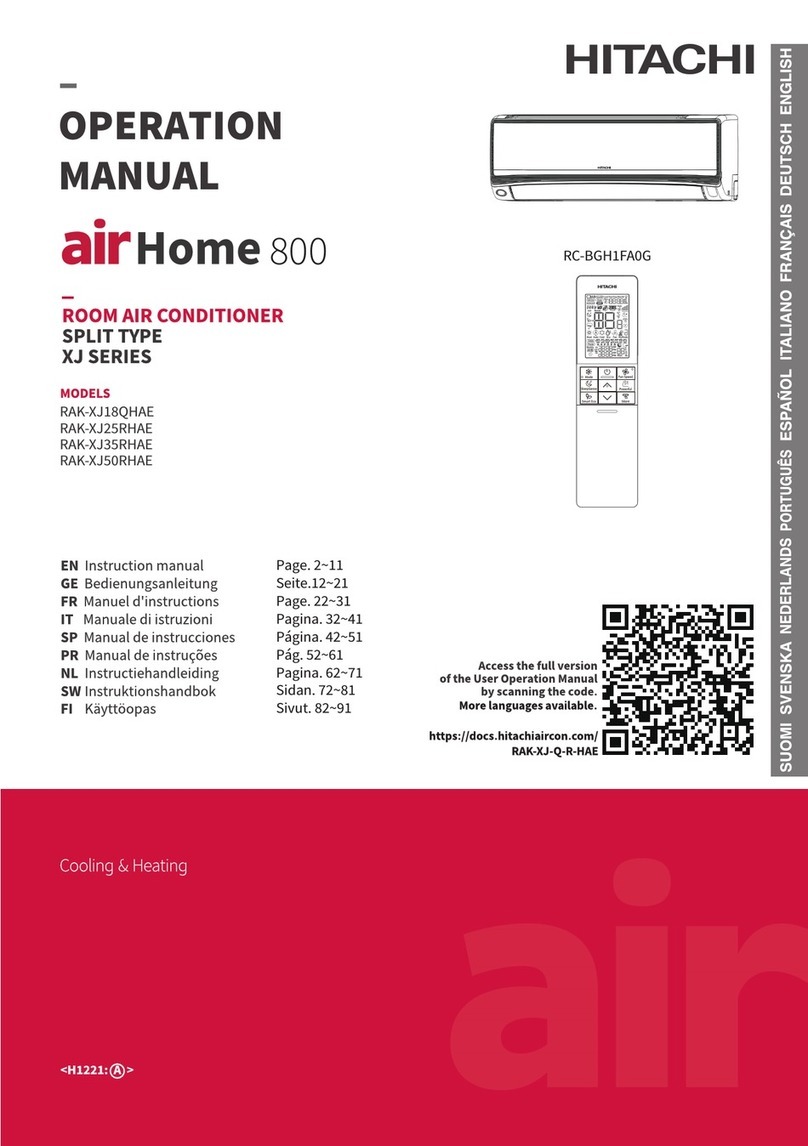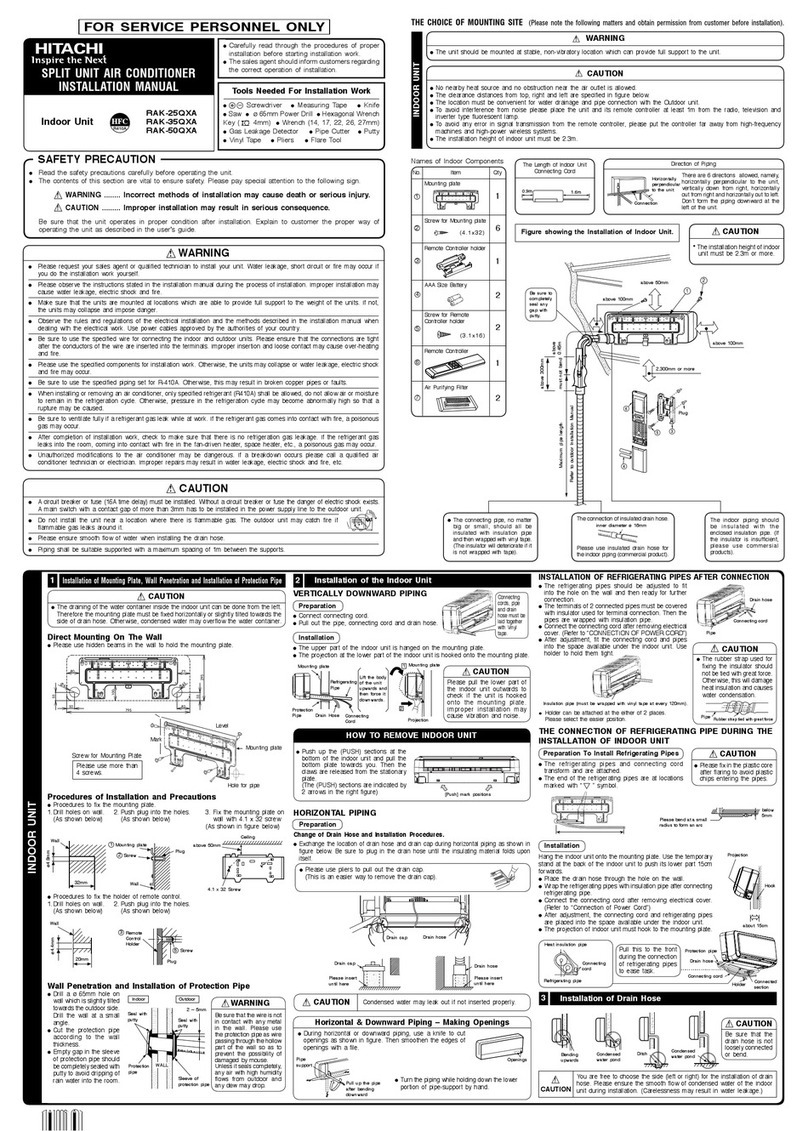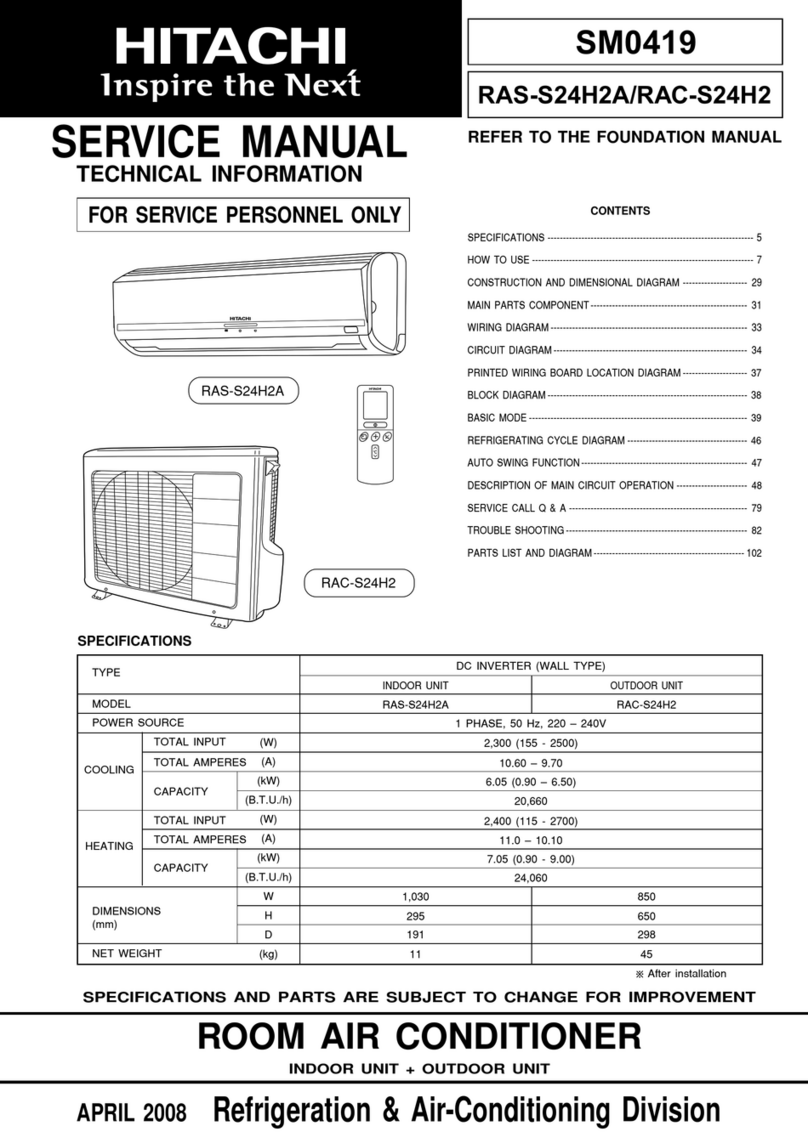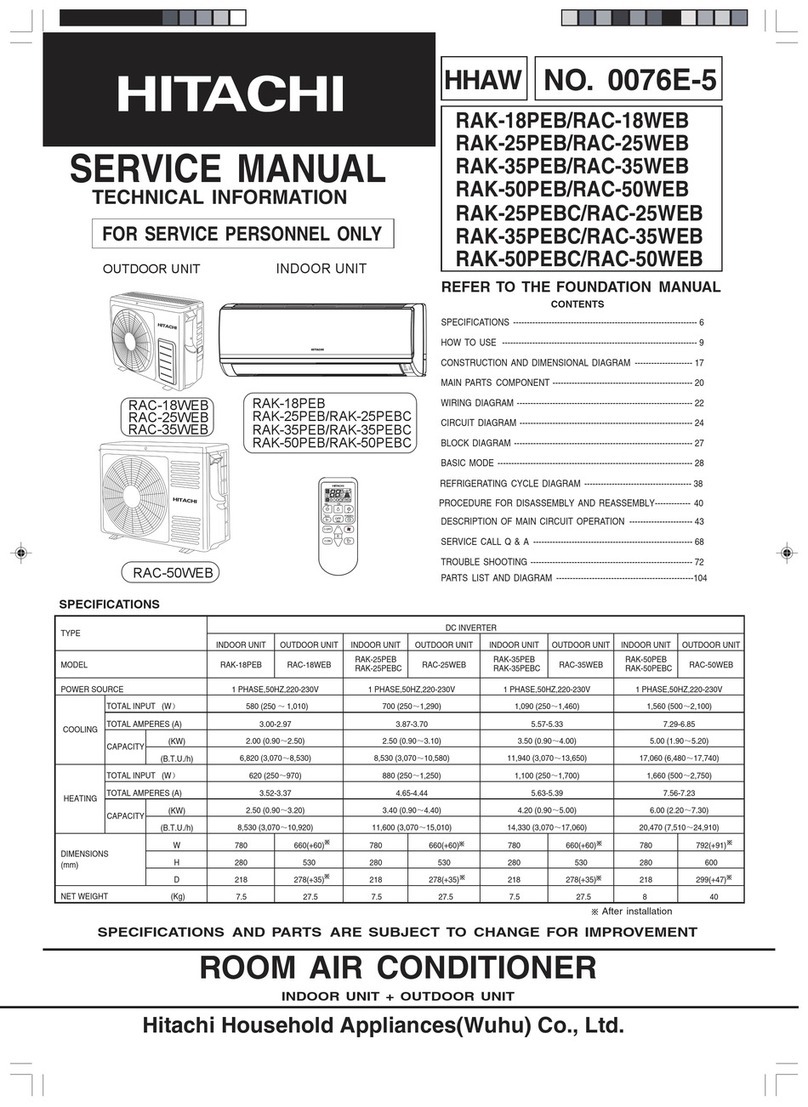Mounting board
Screw for mounting
board
Remote controller
Bush
Drain pipe
Fixed leg dimension of outdoor unit
INDOOR UNIT / OUTDOOR UNIT
Items 8& 9are included in the
package of the outdoor unit.
Heat insulating materials
12
310
299
500
792
330
HITACHI SPLIT UNIT AIR CONDITIONER
INSTALLATION MANUAL
•
Carefully read through the procedures of proper installation
before starting installation work.
•
The sales agent should inform customers regarding the
correct operation of installation.
No nearby heat source and no obstruction near the air outlet is allowed.
The installation height should be at least 2.3m or more from the floor.
The air blown out of the unit should not point directly to animals or plants.
Do not install at a location where there is flammable gas, steam, oil and smoke.
2
1
Direction of Piping
Piping configuration may be in six
different directions: direct rear piping,
left or right downward piping and left
or right sideways piping.
Above 50mm
Be sure to completely seal
any gap with putty.
The space indicated by an
arrow
Á
is to guarantee
the performance of the
air conditioner. Install the
apparatus at the ample
space in order to carry out
the maintenance and repair
works.
Above 50mm
Above 50mm (Above 100mm when there is piping connection at the back of the outdoor unit)
Above 80mm
Above 50mm
give clearance as
widely as possible
When installing the indoor unit
above the curtain rail or curtain
box, allow dimensions not
affecting the airflow.
Maximum pipe length 20m
Above 200mm
Above 200mm
About 300mm
Must not bend
The indoor piping should be
insulated with the enclosed
insulation pipe.
Above 200mm
Above 50 mm when installed
on the ceiling of balcony
Above 100mm
Heating efficiency will be
enhanced if the space below the
outdoor unit is closed so that
no air passes through.
(Procure the material locally.)
The refrigerating machine oil is easily affected
by moisture. Use caution to prevent water from
entering the cycle.
Connection of insulated drain hose
Please use insulated drain hose
for the indoor piping (commercial
product).
Inner diameter
16mm
• The difference in height between the indoor and
outdoor unit should be kept below 10m.
• The connecting pipe, no matter big or small,
should all be insulated with insulation pipe and
then wrapped with vinyl tape. The insulator will
deteriorate if it is not wrapped with tape.
About 0.45m
Horizontally
backward
For outdoor unit installation, allow at least
2 sides of space around the unit to ensure
ventilation flue.
2.3m or more
Figure showing the installation of Indoor and Outdoor Unit (For example: Ground installation)
No. Supplied Items Qty
AAA size battery
Anti-mold wasabi
cassette
1
2
1
Drill a ø65mm hole on wall
which is slightly tilted towards
the outdoor side.
Cut the protection pipe
according to the wall thickness
and pass through the wall
hole.
Empty gap in the sleeve of
protection pipe should be
completely sealed with putty
to avoid dripping of rain water
into the room.
2~5mm
WALL
Putty
Sleeve of
protection
pipe
Protection
pipe
Putty
Indoor Outdoor
2. Installation of the Indoor Unit
2.1 Preparation of Installation
Remove the front panel
•
To remove front panel, please refer to “Removing and
Attaching the Front Panel” on page 13.
•
Make sure to use both hands to attach and remove the front
panel.
Remove the lower cover
•
Push the bottom inner part (1) of the lower cover to remove
the lower cover.
•
To attach the lower cover, attach 2first and then attach 1
by rotating it around 2as the fulcrum.
Remove
Attach
Wiring connection
•
Please refer to “Connection of Power Cord” on page 10.
Cutting lower cover bush
(Horizontal and downward piping)
•
While installing the pipe from the right, left or bottom side,
use a knife to cut lower cover bush accordingly.
•
Use the groove on the outer side if the pipe which is to be
installed from the left side, etc. is big.
Bush part
Groove on the
outer side
Groove on the inner side
Changing of drain hose
(Horizontally piping)
•
Install and change the drain hose and drain cap when installing
the pipe horizontally as shown below.
•
Remove the lower cover when installing and changing.
• Do not carry out horizontal piping for drain hose.
1Remove the screw and
pull out the drain hose.
Drain hose screw
2Insert drain cap up to the
location securely till the
cap stops.
Drain
cap
Drain hose
Drain hose screw
Use the plier to pull and
turn the drain cap for easy
removal.
Push the drain hose deeply
the removed screw during
step 1.
CAUTION
•
Be sure to insert drain hose and drain cap firmly and
fix with screw
Insufficient insert may result in water leakage.
WARNING
•
Protection pipe (commercial product) must be used
Be sure that the wire is not in contact with any metal in the
wall. Please use the protection pipe as wire passing through
the hollow part of the wall to prevent damaged by mouse,
possibility of short circuit or fire.
•
Completely seal with putty
High humidity air inside the wall or the outdoor may go in to
the room and could result in dripping of dew. It could also
cause smell or odor present outdoor and inside the wall
spreading into the room.
Bush part
Drain hose
Preparation of Pipe
Backward piping
Remove the auxiliary insulation material sheet which is
attached to the pipe insulation.
Referring to the mark on the rear side, form the pipe within
the wall hole range.
Wall hole range
Horizontally and downward piping from the right
Remove the auxiliary insulation material sheet which is
attached to the pipe insulation. (Keep the removed auxiliary
insulation material sheet because it will be reused after pipe
connection.)
Carry out refrigerating pipe forming.
Layout of horizontally piping from the right
Temporarily join the refrigerating pipe, drain hose and
connecting cord with tape.
Place the starting point
of refrigerating pipe
bending within the wall
hole range.
Please bend at a small
radius to form an arc.
Pipe
Bottom cover
bush hole
Drain hose
CAUTION
•
Transform the piping while holding down the lower portion
of pipe-support by hand.
If the starting point of refrigerating pipe bending is projected
from the wall hole range or if the bending radius is too large,
the indoor unit may be lifted from wall and this may cause
poor finishing.
Pipe support
Transform after
bending downward
36mm
41mm
Installation after connection of refrigerating pipes
(Horizontal piping)
Remove the auxiliary insulation material sheet which is
attached to the pipe insulation. Connect the refrigerating pipe.
(Refer to “Pipe Connection” on page 9)
Cut the heat insulation sheet refrigerating pipe aligning to
the insulation sheet of the pipe and fix them temporarily with
tape.
Cover the pipe connection with the auxiliary insulation sheet
which was removed earlier, with its split line on the top. Wrap
the tape without any gap. Tape must not be over tightened.
(
Refer to “Heat insulation and Finishing of Piping” on page 11)
If there is gap or over-tightened, it may cause condensation.
Refrigerating
pipe
Pipe
Auxiliary insulation
sheet
Refrigerating pipe
insulation sheet
Refrigerating pipe
insulation sheet Cut Refrigerating
pipe
About 90mm
Temporarily
wrap with tape
Split line of the auxiliary
insulation sheet must
be positioned within this
range.
Pipe support
Auxiliary insulation
sheet
Place the
ending point of
refrigerating pipe
bending within
this range.
Pipe support
Refrigerating pipe
Center line of wall hole
Place the
refrigerating
pipe bending
within the wall
hole range
ø65 wall
hole range
Drain
hose
24mm
36~41mm
56.5mm
Temporarily join the refrigerating pipe, drain hose and
connecting cord together with tape.
Temporarilyjoin the refrigerating pipe,
drain hose and connecting cord
together with tape.
Wrap the wall hole portion with tape.
Wrap with tape
Pipe
Connecting
cord Drain hose
Pipe support
Refrigerating pipe
Center line of wall hole
Place the
refrigerating
pipe bending
within the wall
hole range
ø65 wall
hole range
Drain
hose
24mm
36~41mm
56.5mm
Auxiliary insulation sheet
Connecting the refrigerating pipe at the back of the
indoor unit
Remove the auxiliary
insulation material sheet
which is attached to the
pipe insulation. (Keep
the removed auxiliary
insulation material sheet
because it will be reused
after pipe connection.)
Hang the indoor unit on the mounting board.
Place the cushion under the right rear surface of the indoor
unit to lift the lower side of the unit by approximately 15cm.
Connect the refrigerating pipe. (Refer to “Pipe Connection”
on page 9)
Cover the pipe connection with the auxiliary insulation sheet
which was removed earlier, with its split line on the top.
Wrap the tape without any gap. (Refer to “Installation after
connection of refrigerating pipes (Horizontal piping)” on page
5, step 3)
Insert the drain hose into the wall hole.
Connect the connecting cord. (Refer to “Connection of Power
Cord” on page 10).
Form connecting cord and refrigerating pipe and put them in
the space on the lower side of the rear surface of the indoor
unit.
Remove the temporary stand and hook the projection on the
lower part of the indoor unit onto the mounting board.
CAUTION
•
Do not over tighten vinyl tape on pipe heat insulation
sheet
Do not over tighten to avoid loss of heat insulating effect
and dew condensation.
•
Pull the lower part of the indoor unit towards you
installation plate
If the tab is not fitted in securely, vibration of the indoor unit
becomes stronger.
Protection pipe
Drain hose
CAUTION
•
During drainage work, install the drain pipe to ensure
smooth drainage. Make sure to carry out drainage
check.
Careless work may result in water leakage.
•
Make sure that there is no problem as shown in the
figures on page 8.
Such problems may cause clogged drain and could result
in water leakage.
•
Drain hose must be at a slope of at least 1/25.
•
When inserting the drain hose into the drain pipe for
embedded piping, etc., do not cut the drain hose in the
middle.
This may lead to poorer heat insulating performance of the
drain hose and could result in water leakage.
•
Do not lead the drain hose to a place where corrosive
gas (sulfur, ammonia, etc.) is generated such as septic
tank.
hose, and could result in corrosion on the copper pipe and
odor in the room.
3. Drainage Check
After the indoor unit is installed, please ensure the smooth
(Careless work may result in water leakage.)
How to remove the indoor unit
•
Push the [PUSH] section at the bottom of the indoor unit
from the outside, the claws are released from the mounting
board. (2 places on the left and right)
•
If the bottom of the indoor unit cannot be pushed, remove
the bottom part of the front cover and insert a screwdriver
into the hole for removal of indoor unit as shown in the
figure. Then, push the claws upwards while holding down
the upper part of the hole 1and pull the indoor unit towards
you 2. When horizontal piping is used, be careful not to
damage the pipe and connecting cord with the tip of the
screwdriver during this operation.
•
Please refer to “Removing and Attaching the Front Cover”
on page 14 to remove the bottom part of the front cover.
Projection
of the
indoor unit Fixing
tab
Cushion
About 15cm
Auxiliary insulation
sheet
Refrigerating pipe
Connecting cord
Pull this to the front during
the connection of refrigerating
pipe to ease task.
Auxiliary insulation sheet
Connection part
Connecting cord
Screwdriver
Hold with hand
Hole for removal Claw
Mounting board
Hole for removal
Form the refrigerating pipe according to the wall hole
position.
Especially in the case of horizontally backward piping,
follow the instruction below to carry out accurate forming.
Forming of refrigerating pipe for horizontally backward
piping
(1)Refer to the mark at the back, start bending the
refrigerating piping within wall hole range.
Connecting the refrigerating pipe at the back of the
indoor unit
•
Form and set the refrigerating pipe and connecting cord.
If the starting point of refrigerating pipe bending is
projected from the wall hole range or if the bending
radius is too large, the indoor unit may be lifted from
wall and this may cause poor finishing.
2.2 Installation
Connecting the refrigerating pipe other than at the back
of the indoor unit
Insert the pipes through the wall hole.
Hang the upper part of the i ndoor unit on the mounting
board.
Push the lower part of the indoor unit to the wall, hook
the projection on the lower part of the indoor unit onto the
mounting board.
Cover the pipe connection with the auxiliary insulation sheet
which was removed earlier, with its split line on the top. Wrap
the tape without any gap. (Refer to “Heat insulation and
Finishing of Piping” on page 11)
If there is gap or over-tightened, it may cause condensation
.
CAUTION
•
Place the starting point of
refrigerating pipe bending within
the wall hole range.
Please bend at a small
radius to form an arc.
(2) When forming, bend the refrigerating pipe with the
smallest radius.
Refrigerating
pipe
Center line of
wall hole
ø65 wall hole
range
Drain
hose Refrigerating
pipe
Form the connecting cord and refrigerating pipe and put
them in the space on the lower side of the rear surface
of the indoor unit. Put the binding band on the hook
located on the rear surface to fix it.
Join refrigerating pipe, connecting cord and drain hose
temporarily with tape and wrap the wall hole portion with
tape.
Be sure to cut the extra binding band.
(Otherwise, it may result in abnormal noise or dewfall.)
Hook
Binding band
Wrap with tape
Binding band can be
installed to whichever
side of the installation
points. However, it is
recommended to attach it
on the right side viewing
from the rear.
Match the end of the refrigerating pipes with the
locations marked with “V” symbol.
Insert a plastic hose (commercial product)
into the large diameter pipe.
Below 5mm
1.00m
Please bend at a small radius to form an arc. (Pipe can be bent with
a small radius without being crushed if a plastic hose is used.)
Projection of the indoor unit
Mounting board
Mounting board
Protection pipe
Refrigerating pipe
Connecting cord
Drain hose
Small
diameter Large diameter
FOR SERVICE PERSONNEL ONLY
1.3 Wall Penetration and Installation of Protection Pipe
OUTDOOR UNIT
Bending
upwards
Condensed
water pond
Ditch Condensed
water pond
CAUTION
Be sure that the drain hose is loosely connected
CAUTION
You are free to choose the side (left or right) for
the installation of drain hose. Please ensure the
during installation. (Careless may result in water
leakage.)
•
Please mount the outdoor unit on stable ground to
prevent vibration and increase of noise level.
•
Decide the location for piping after sorting out the
different types of pipe available.
•
When removing side cover, please pull the handle
after undoing the hook by pulling it downward.
Reinstall the side cover in reverse order of the
removal.
Please face this side (suction side)
of the unit to the wall.
Please remove side cover
when connecting the piping
and connecting cord.
Pull
downward
Elevated stand
Tent
In snowy region, install a snow guard and elevated stand
In other regions, it is recommended to install a tent for
shade.
CAUTION
Do not touch the suction port, bottom surface
Failure to do so may cause an injury.
Drain cap Drain hose
6
5
•
smooth flow of condensed water of the indoor unit
bend or proper condition like left figure.
to ensure the airflow for better heating efficiency.
or aluminium fin of the outdoor unit.
into the screw hole, fix with
When using a plastic hose, make sure to insert it only
after pipe expanding is carried out to avoid cutting
dust from getting inside.
flow of condensed water of the indoor unit during installation.
Corrosive gas may flow into the indoor unit through the drain
and confirm that the tab of the indoor unit is fit in the
RAK-18_25_35PSA_EN.indd 1 2013-2-28 15:56:15
Minimum pipe length 3m
Press it into the
hole in the chassis
DRAIN PIPE
above
100mm
BUSH
Press it into the
hole in the chassis
RAK-25PSB/RAC-25WSB
RAK-18PSB/RAC-18WSB
RAK-35PSB/RAC-35WSB
Plug
Remote Controller Holder
Screw for Remote
Controller Holder
@
3
4
5
@
SAFETY PRECAUTION
sRead the safety precautions carefully before operating the unit.
sThe contents of this section are vital to ensure safety. Please pay special attention to the following sign.
WARNING .......... Incorrect methods of installation may cause death or serious injury.
CAUTION .......... Improper installation may result in serious consequence.
Make sure to connect earth line.
This sign in the figures indicates prohibition.
Be sure that the unit operates in proper condition after installation. Explain to customer the proper operation and maintenance of
the unit as described in the user' s guide. Ask a customer to keep this installation manual together with the instruction manual.
WARNING
sPlease request your sales agent or qualified technician to install your unit. Water leakage, short circuit or fire may occur if you do the
installation work yourself.
sPlease observe the installation stated in the installation manual during the process of installation. Improper installation may cause
water leakage, electric shock and fire.
sMake sure that the units are mounted at locations which are able to provide full support to the weight of the units. If not, the units may
collapse and impose danger.
sObserve the rules and regulations of the electrical installation and the methods described in the installation manual when dealing
with the electrical work. Use cables which are approved official in your country. Be sure to use the specified circuit.A short circuit and
fire may occur due to the use of low quality wire or improper work.
sBe sure to use the specified cables for connecting the indoor and outdoor units. Please ensure that the connections are tight after the
conductors of the wire are inserted into the terminals to prevent the external force is being applied to the connection section of the
terminal base. Improper insertion and loose contact may cause over-heating and fire.
sPlease use the specified components for installation work. Otherwise, the unit may collapse or water leakage, electric shock, fire or
stronger vibration may occur.
sBe sure to use the specified piping set for R410A. Otherwise, this may result in broken copper pipes or faults.
sWhen installing or transferring an air conditioner to another location, make sure that air other than the specified refrigerant (R410A)
does not enter the refrigeration cycle. If other air should enter, the pressure level of the refrigeration cycle may increase abnormally
which could result in a rupture and injury.
sBe sure to ventilate fully if a refrigerant gas leak while at work. If the refrigerant gas comes into contact with fire, a poisonous gas may
occur.
sAfter completion of installation work, check to make sure that there is no refrigeration gas leakage. If the refrigerant gas leaks into the
room, coming into contact with fire in the fan-driven heater, space heater, etc., a poisonous gas may occur.
sUnauthorized modifications to the air conditioner may be dangerous. If a breakdown occurs please call a qualified air conditioner
technician or electrician. Improper repairs may result in water leakage, electric shock and fire, etc.
sBe sure to connect the earth line from the power supply wire to the outdoor unit and between
the outdoor and indoor unit. Do not connect the earth line to the gas tube, water pipe, lighting rod or the earth line of the
telephone unit. Improper earthing may cause electric shocks.
sWhen finishing the refrigerant collection (pumping down), stop the compressor and then remove the coolant pipe.
If you remove the refrigerant pipe while the compressor is operating and the service valve is released, air is sucked and a
pressure in the freezing cycle system will build up steeply, causing an explosion or injury.
sWhen installing the unit, be sure to install the refrigerant pipe before starting the compressor.
If the refrigerant pipe is not installed and the compressor is operated with the service valve released, air is sucked and the
pressure level of the refrigeration cycle may increase abnormally which could result in a rupture and injury.
CAUTION
sA circuit breaker must be installed in the house distribution box for the direct connected power supply cables to the
outdoor unit. In case of other installations a main switch with a contact gap of more than 3mm has to be installed.
Without a circuit breaker, the danger of electric shock exists.
sDo not install the unit near a location where there is flammable gas. The outdoor unit may catch fire
if flammable gas leaks around it.
sPlease ensure smooth flow of water when installing the drain hose. Improper installing may wet your funiture.
sAn IEC approved power cord should be used. Power cord type: NYM.
The electric cables should neither be reworked nor added.
Make sure to use an exclusive circuit breaker.
Otherwise fire or electric shock might occur by connection failure, isolation failure or over current.
Make sure to connect cables to terminal properly and terminal cover should close firmly.
Otherwise, over heating at terminal contact, fire or electric shock might occur.
Make sure that there is no dust on any connected points of electric cables and fix firmly.
Otherwise, fire or electric shock might occur.
s
s
s
Drain hose
Leveler
Mounting
board
Mark
Line Weight Pipe hole
Board
anchor
Screw fixing
the mounting
board
on
sPlease use hidden beams in the wall to hold the hanger.
1.2 Procedures of Installation and Precautions
sProcedures to fix the hanger.
1.Drill holes on wall.
(As shown below)
2.Push plug into the holes.
(As shown below)
3.Fix the hanger on wall with
4.1 x 32 screw.
(As shown in figure below)
32mm
Wall
ømm8.
4
Hanger
Screw
Wall
Plug
(Procure
locally)
Screw the hanger at the
positions possibly near the
upper and lower hooks where
the indoor unit is hung.Use 4 or
more screws to fix the hanger.
Ceiling
798mm
450mm
450mm 100mm
175mm
600mm 80mm
350mm
638mm
80mm
42.5mm
200mm
295mm
58mm
52mm
Dimensions of
indoor unit
1.1
When Using and Installing In Cold Areas
EN
